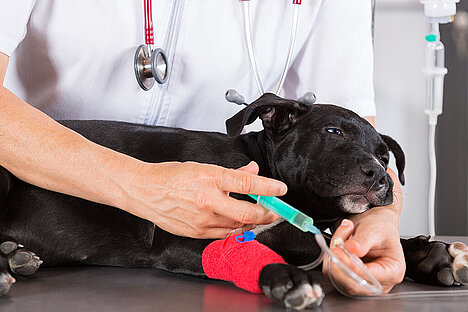Acidosis

Acidosis is a condition in which the pH value of the blood is too low. This means that the blood is too acidic. This can lead to various health problems in dogs, such as weakness, shortness of breath, vomiting or even coma and death. In this article, you'll learn what the causes and symptoms of acidosis in dogs are, how to recognize and treat it, and how to prevent it.
What are the causes of acidosis in dogs?
There are various factors that can lead to acidosis in dogs. The most common are:
- Diabetes mellitus: if your dog suffers from diabetes, their body cannot regulate blood sugar properly. This can cause too much glucose to build up in the blood, which is broken down into acid. This is called diabetic ketoacidosis.
- Kidney failure: If your dog's kidneys are no longer working properly, they can no longer filter enough acid from the blood. This is called metabolic acidosis.
- Vomiting or diarrhea: If your dog vomits a lot or has diarrhea, it loses a lot of fluids and electrolytes. This can disrupt the acid-base balance in the blood and lead to acidosis.
- Lung problems: If your dog has breathing problems, he won't be able to exhale enough carbon dioxide. This can lower the pH of the blood and lead to respiratory acidosis.
What are the symptoms of acidosis in dogs?
Symptoms of acidosis in dogs can vary depending on the severity and cause. Some of the most common are:
- Loss of appetite
- lethargy
- Weakness
- Rapid or shallow breathing
- Vomiting or diarrhea
- Dehydration
- Tremors or convulsions
- Loss of consciousness or coma
How is acidosis diagnosed in dogs?
To diagnose acidosis in dogs, your vet will need to carry out a blood test. This will measure the pH value of the blood, as well as the levels of glucose, electrolytes and other substances. Your vet will also examine your dog clinically and look for possible causes of acidosis.
How is acidosis treated in dogs?
The treatment of acidosis in dogs depends on the cause and severity. Typically, your dog will need to be given intravenous fluids and electrolytes to compensate for fluid loss and normalize blood pH. In addition, the underlying cause must be treated, for example with insulin for diabetes or medication for kidney failure or lung problems. In severe cases, your dog may also need oxygen or artificial respiration.
How can you prevent acidosis in dogs?
To prevent acidosis in dogs, you should make sure that your dog always drinks enough water and has a balanced diet. You should also have their health checked regularly and look out for signs of diabetes, kidney failure or lung problems. If your dog suffers from a chronic illness, you should monitor his condition closely and give him the prescribed medication.
The authors assume that a veterinarian should be consulted if an animal is ill and that medication should only be taken after consultation with a doctor or pharmacist. Only an individual examination can lead to a diagnosis and treatment decision.
We help you find the nearest vet → This way